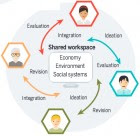Do we have free will?
| January 8, 2016 |
 |
Neuroscientists run the ultimate experiment to find out: a "duel" between human and brain-to-computer interface (BCI)
It’s a question that’s been debated by philosophers for centuries. Now neuroscientists from Charité – |
| December 29, 2015 |
 |
Could lead to better ways to identify and treat brain diseases and to new deep-learning AI systems
Ever wonder how your brain creates your thoughts, based on everything that’s happening around you (and within you), and where these thoughts are actually located in the brain? UMass Amherst computational neuroscientist Hava Siegelmann has, and she created a geometry-based method for doing just that. Her team did a massive data analysis of 20 years … more… |
| January 5, 2016 |
 | Human Computation Institute | Dr. Pietro Michelucci “Human computation” — combining human and computer intelligence in crowd-powered systems — might be what we need to solve the “wicked” problems of the world, such as climate change and geopolitical conflict, say researchers from the Human Computation Institute (HCI) and Cornell University. In an article published in the journal Science, the authors … more… |
Cognitive-stimulation experiment suggests new tools for healthy brain aging
| January 8, 2016 |
 |
May also have a "preventive and therapeutic role in association with early AD-type neurodegeneration"
Neuroscientists in Italy and the U.K. have developed cognitive-stimulation exercises and tested them in a month-long experiment with healthy aging adults. The exercises were based on studies of the brain’s resting state, known as the “default mode network”* (DMN). In a paper published in Brain Research Bulletin, the researchers explain that in aging (and at a … more… |
No comments:
Post a Comment